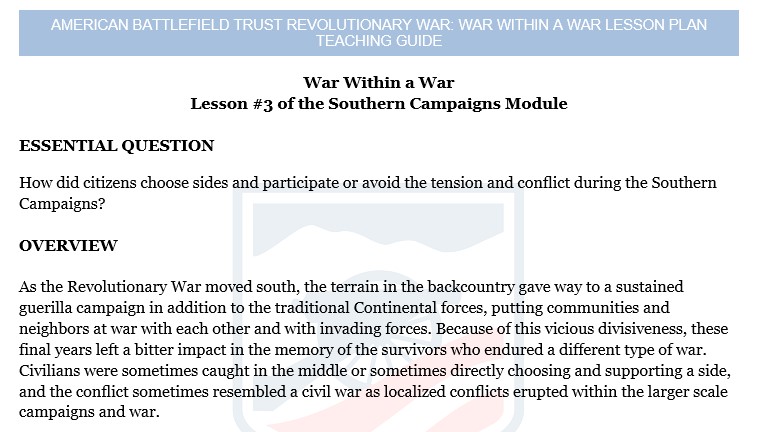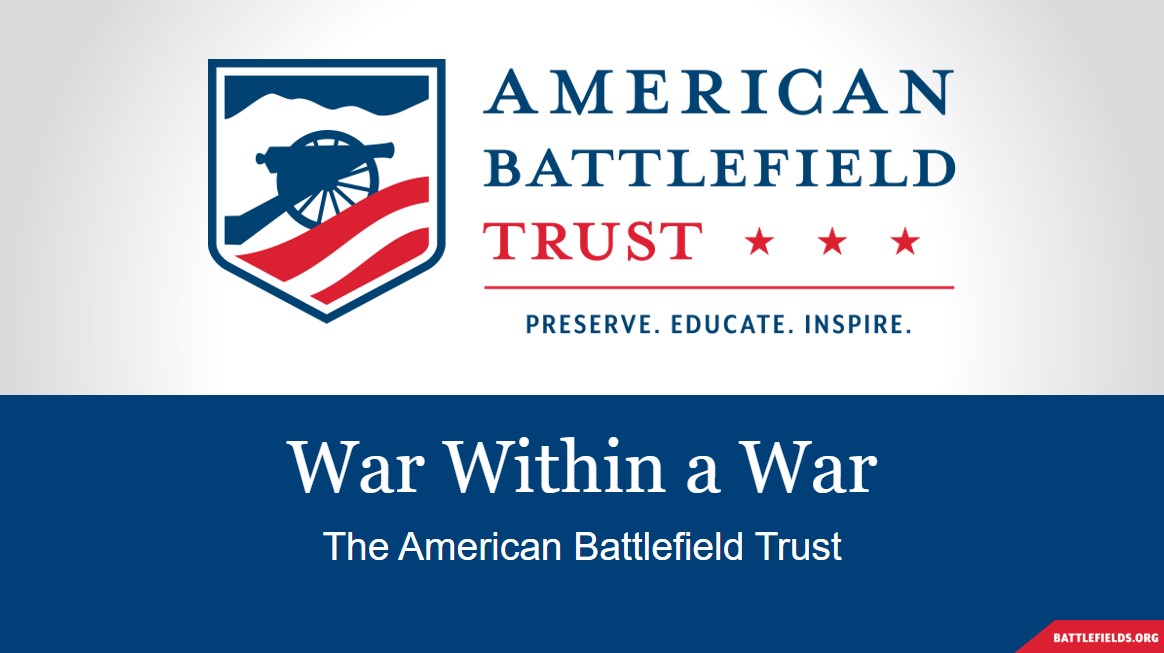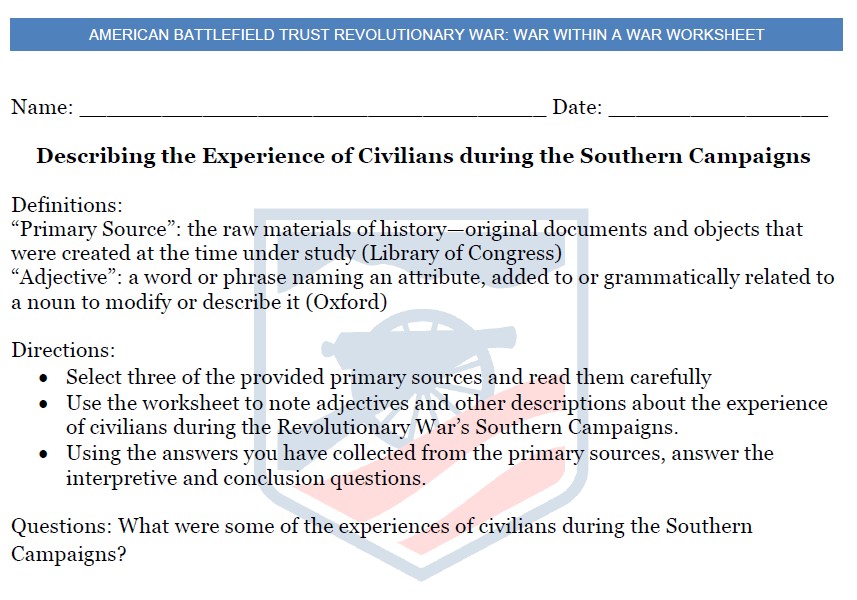
“General Francis Marion Inviting A British Officer to Share His Meal or The Swamp Fox” by John Blake White, c. 1810.
War Within a War Lesson Plan
A lesson plan for use in middle and high school classrooms.
As the Revolutionary War moved south, the terrain in the backcountry gave way to a sustained guerilla campaign in addition to the traditional Continental forces, putting communities and neighbors at war with each other and with invading forces. Because of this vicious divisiveness, these final years left a bitter impact in the memory of the survivors who endured a different type of war. Civilians were sometimes caught in the middle or sometimes directly choosing and supporting a side, and the conflict sometimes resembled a civil war as localized conflicts erupted within the larger scale campaigns and war.
This Lesson Plan can be used as a prepared resource by following this curriculum plan which aligns to NCSS and Common Core Standards.
This Lesson Plan's assets can also be used on their own as supplemental resources. The display format is prepared for easy access, exploring, and learning.
The Southern Campaigns Module
Upon completion of this lesson, the students will be able to:
1. Knowledge
- Describe some of the divisions and conflict that existed among communities and neighbors during the Southern Campaigns of the Revolutionary War.
- Discuss the experiences of civilians caught or participating in the war.
2. Comprehension/Application/Analysis
- Examine primary sources about a civilians during the Revolutionary War and analyze findings.
3. Evaluation
- Evaluate the primary sources for author’s bias and consider the different sides and perspectives of the Revolutionary War.
Check out the Lesson Plan Teaching Guide for more instructions on using the prepared Lesson Plan.
Lesson Plan Primary Source Activity:
- Use the Lesson’s PowerPoint to explore the context and history; the PowerPoint introduces Essential Questions and lays foundational knowledge about the conflict.
- Watch “Was the American Revolution a Civil War?” (3 minutes)
- If time permits, read this article for additional context: "Bloody Ban" in the Backcountry: Legacy of America's First Civil War
- Distribute the primary source worksheet and students can work individually or in groups.
- Have the students select three primary sources to read and take notes from; then complete the worksheet and share their discoveries.
- 6 selected primary sources are available under the “Primary Source” section this lesson plan page.
OPTIONAL HOMEWORK/ASSESSMENT/ADDITIONAL ACTIVITIES:
Option 1: Biography Study
Have the students selected a historical person connected to the Southern Campaign. (There are six biography articles already prepared on the Lesson Plan Page). The students will read the biography and make notes for the following topics. Students can write a short essay, share their findings verbally, or incorporate their findings into a larger class project that might include art, costumes, or props.
Key Life Events:
Identify and describe three key events or milestones in the life of the individual. How did these events shape or influence their character, achievements, or contributions?
Legacy and Impact:
Reflect on the individual's lasting legacy and impact on society. What are the person's major contributions or accomplishments? Do you think these accomplishments were good? How have their actions influenced the course of history or inspired others?
Option 2: Considering Options
Invite a class discussion or a short essay to consider and answer the opinion question: what would you have done if you lived in the divided backcountry during the Revolutionary War? Have the students consider some of the options, including: enlisting in the army (British or American/Continental), joining a partisan group (Loyalist or Whig), moving further west into or beyond the Appalachian Mountains, trying to make a peaceful deal, ignoring the conflicts and hoping for the best.
Common Core State Standards- ELA & History/Social Studies
Grades 6-8
- Key Ideas and Details:
- CCSS.ELA-LITERACY.RH.6-8.1
- Cite specific textual evidence to support analysis of primary and secondary sources.
- CCSS.ELA-LITERACY.RH.6-8.1
- Craft and Structure:
- CCSS.ELA-LITERACY.RH.6-8.4
- Determine the meaning of words and phrases as they are used in a text, including vocabulary specific to domains related to history/social studies.
- CCSS.ELA-LITERACY.RH.6-8.6
- Identify aspects of a text that reveal an author's point of view or purpose (e.g., loaded language, inclusion or avoidance of particular facts).
- CCSS.ELA-LITERACY.RH.6-8.4
Grades 9-10
- Key Ideas and Details:
- CCSS.ELA-LITERACY.RH.9-10.1
- Cite specific textual evidence to support analysis of primary and secondary sources, attending to such features as the date and origin of the information.
- CCSS.ELA-LITERACY.RH.9-10.1
- Craft and Structure:
- CCSS.ELA-LITERACY.RH.9-10.4
- Determine the meaning of words and phrases as they are used in a text, including vocabulary describing political, social, or economic aspects of history/social science.
- CCSS.ELA-LITERACY.RH.9-10.6
- Compare the point of view of two or more authors for how they treat the same or similar topics, including which details they include and emphasize in their respective accounts.
- CCSS.ELA-LITERACY.RH.9-10.4
- Integration of Knowledge and Ideas:
- CCSS.ELA-LITERACY.RH.9-10.8
- Assess the extent to which the reasoning and evidence in a text support the author's claims.
- CCSS.ELA-LITERACY.RH.9-10.8
Grades 11-12
- Key Ideas and Details:
- CCSS.ELA-LITERACY.RH.11-12.3
- Evaluate various explanations for actions or events and determine which explanation best accords with textual evidence, acknowledging where the text leaves matters uncertain.
- CCSS.ELA-LITERACY.RH.11-12.3
- Craft and Structure:
- CCSS.ELA-LITERACY.RH.11-12.4
- Determine the meaning of words and phrases as they are used in a text, including analyzing how an author uses and refines the meaning of a key term over the course of a text (e.g., how Madison defines faction in Federalist No. 10).
- CCSS.ELA-LITERACY.RH.11-12.6
- Evaluate authors' differing points of view on the same historical event or issue by assessing the authors' claims, reasoning, and evidence.
- CCSS.ELA-LITERACY.RH.11-12.4
Social Studies - National Council for the Social Studies
- Theme 2: Time, Continuity, and Change
- Theme 3: People, Places, and Environments
- Theme 5: Individuals, Groups, and Institutions
- Theme 6: Power, Authority, and Governance
- Theme 7: Production, Distribution, and Consumption
- Theme 9: Global Connections
This Lesson plan
contains the following:
3 Activities | 21 Resources
Audience: Middle school | High school
This Lesson plan is a part of:
Revolutionary War Curriculum | The Southern Campaigns Module






